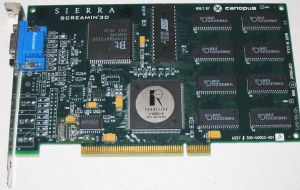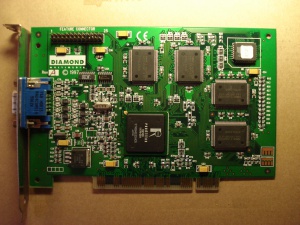Difference between revisions of "Rendition"
(→V1000) |
(→V2x00) |
||
| Line 16: | Line 16: | ||
The second generation Vérité chip is similar in design to the V1000 but it has been drastically enhanced with a focus on single-cycle operation. V2200 can get much more work done per clock than the V1000 and this improves both 2D and 3D performance. The chip was offered in a budget form as V2100 and a high-end model as V2200 although both are identical and clock speed is the only differentiation. V2100 operates at 40-45 MHz while V2200 is 55-60 MHz. Memory is 4-8 MB SGRAM operating asynchronously, by default usually clocked twice as high as the chip clock. V2x00 is AGP capable but operates as a 66 MHz PCI device, without AGP's special features. | The second generation Vérité chip is similar in design to the V1000 but it has been drastically enhanced with a focus on single-cycle operation. V2200 can get much more work done per clock than the V1000 and this improves both 2D and 3D performance. The chip was offered in a budget form as V2100 and a high-end model as V2200 although both are identical and clock speed is the only differentiation. V2100 operates at 40-45 MHz while V2200 is 55-60 MHz. Memory is 4-8 MB SGRAM operating asynchronously, by default usually clocked twice as high as the chip clock. V2x00 is AGP capable but operates as a 66 MHz PCI device, without AGP's special features. | ||
| − | Unfortunately | + | Unfortunately V2x00 is not able to perform per-pixel mip-mapping, something even Voodoo 1 could do. Legacy VGA modes are also still very slow. |
| − | + | ||
===V3300=== | ===V3300=== | ||
Revision as of 18:48, 22 February 2013
Rendition was a graphics chip manufacturer that produced cards for PCs from 1996 through 1999.
Vérité
V1000
V1000 was one of the earliest chips with 2D, 3D and video functions all integrated into one ASIC while also providing impressive performance all around. It still used an external RAMDAC, which was common at the time. The GUI acceleration is adequate but not exceptional. DirectDraw and VESA VBE 2.0 functions are fast. All V1000 cards are equipped with 4MB of EDO DRAM running synchronously with the graphics chip.
The chip is based upon MIPS-like RISC CPU technology with microcode programmability and a fixed-function pixel engine. The programmable flexibility allowed the chip to be tweaked for various use cases. Its 3D capabilities were second only to Voodoo Graphics in 1996. 3D performance is perhaps around 50% of Voodoo. V1000 is best utilized with Rendition's APIs, Speedy3D (DOS) and RRedline (Win9x). Direct3D is less optimal for it though Direct3D 5 games like Jedi Knight are quite playable. The chip is not really adequately capable of OpenGL although there is an ICD available.
Legacy VGA modes are very slow. For example Doom, which uses VGA Mode X, will run at around 10 fps on a Pentium III. There is a DOS utility program to remap some VGA modes to VESA VBE modes, but Mode X can not be improved in this manner.
There are two V1000 chips, V1000E and V1000L. V1000L operates on 3.3v instead of 5v and so uses less power and may be slightly higher clocked. V1000E boards should be used with the available BIOS update TSR for improved performance.
V2x00
The second generation Vérité chip is similar in design to the V1000 but it has been drastically enhanced with a focus on single-cycle operation. V2200 can get much more work done per clock than the V1000 and this improves both 2D and 3D performance. The chip was offered in a budget form as V2100 and a high-end model as V2200 although both are identical and clock speed is the only differentiation. V2100 operates at 40-45 MHz while V2200 is 55-60 MHz. Memory is 4-8 MB SGRAM operating asynchronously, by default usually clocked twice as high as the chip clock. V2x00 is AGP capable but operates as a 66 MHz PCI device, without AGP's special features.
Unfortunately V2x00 is not able to perform per-pixel mip-mapping, something even Voodoo 1 could do. Legacy VGA modes are also still very slow.
V3300
The V3300 was to be Rendition's third generation 3D graphics chipset and was initially scheduled for release in 1999. It was never released, likely because it was not going to be adequately competitive.
- Dual Pixel Engine
- dual-texturing for bilinear and trilinear filtering
- specular highlighting (per vertex), Anti-aliasing
- 3 million triangles/second triangle setup engine, 200 million pixels/s trilinear fillrate
- Dual independent 250 MHz RAMDAC CRT controllers
- iDCT transformations & motion compensation support (DVD playback acceleration)
- Compatible with 166 MHz SDRAM/SGRAM
- 128-bit bus architecture
- AGP 2X execute mode support
- 0.35 μm process
V4400
After canceling V3300, Rendition accelerated development of V4400. This chip was to utilize Micron's EDRAM technology and have 4MB of integrated memory. The project was eventually canceled.
Related links
- Gona's V1000-E vs. V1000L-P benchmarks
- Vintage3D - Rendition sections with benchmarks and screenshots
- VOGONS Drivers - Rendition section

